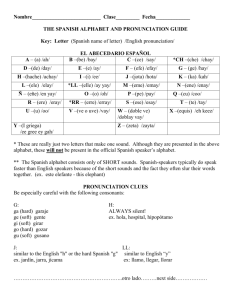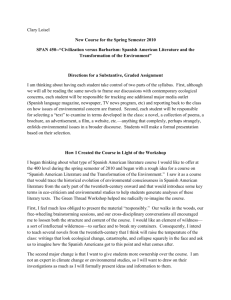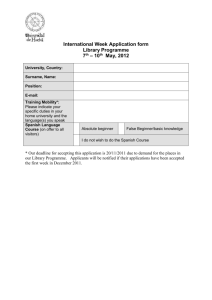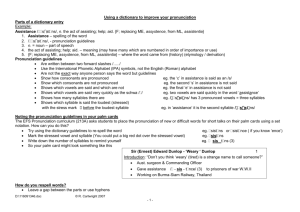CA in English/Spanish Stress and Intonation Patterns
advertisement
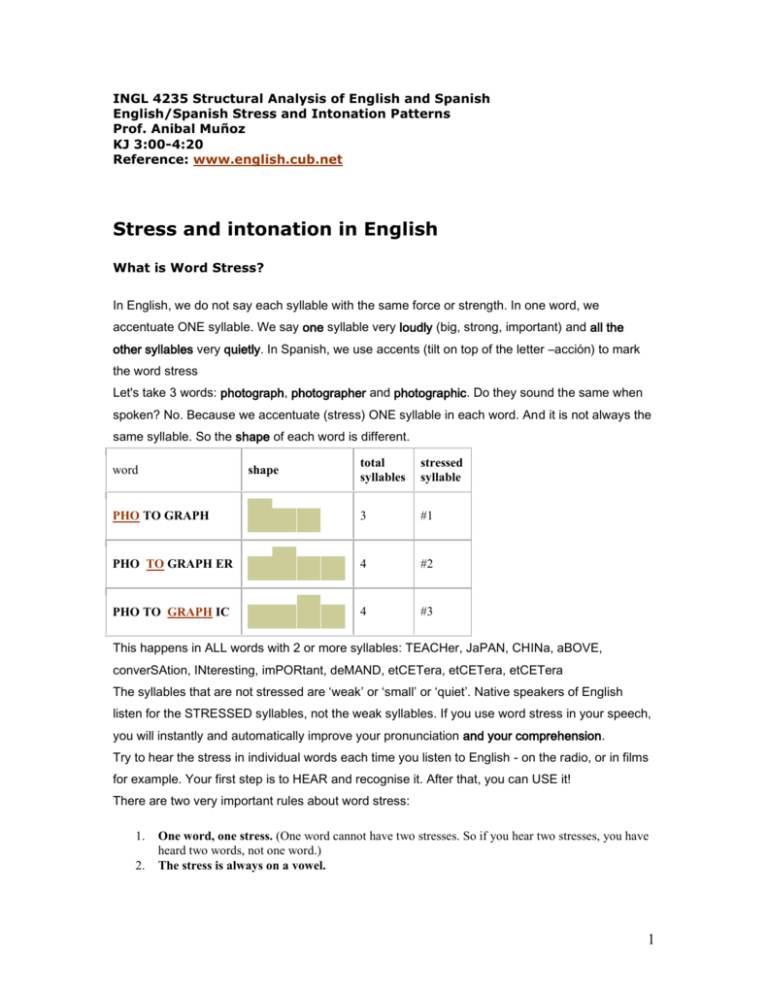
INGL 4235 Structural Analysis of English and Spanish
English/Spanish Stress and Intonation Patterns
Prof. Anibal Muñoz
KJ 3:00-4:20
Reference: www.english.cub.net
Stress and intonation in English
What is Word Stress?
In English, we do not say each syllable with the same force or strength. In one word, we
accentuate ONE syllable. We say one syllable very loudly (big, strong, important) and all the
other syllables very quietly. In Spanish, we use accents (tilt on top of the letter –acción) to mark
the word stress
Let's take 3 words: photograph, photographer and photographic. Do they sound the same when
spoken? No. Because we accentuate (stress) ONE syllable in each word. And it is not always the
same syllable. So the shape of each word is different.
total
syllables
stressed
syllable
PHO TO GRAPH
3
#1
PHO TO GRAPH ER
4
#2
PHO TO GRAPH IC
4
#3
word
shape
This happens in ALL words with 2 or more syllables: TEACHer, JaPAN, CHINa, aBOVE,
converSAtion, INteresting, imPORtant, deMAND, etCETera, etCETera, etCETera
The syllables that are not stressed are ‘weak’ or ‘small’ or ‘quiet’. Native speakers of English
listen for the STRESSED syllables, not the weak syllables. If you use word stress in your speech,
you will instantly and automatically improve your pronunciation and your comprehension.
Try to hear the stress in individual words each time you listen to English - on the radio, or in films
for example. Your first step is to HEAR and recognise it. After that, you can USE it!
There are two very important rules about word stress:
1.
2.
One word, one stress. (One word cannot have two stresses. So if you hear two stresses, you have
heard two words, not one word.)
The stress is always on a vowel.
1
Where do I Put Word Stress?
There are some rules about which syllable to stress. But...the rules are rather complicated!
Probably the best way to learn is from experience. Listen carefully to spoken English and try to
develop a feeling for the "music" of the language.
When you learn a new word, you should also learn its stress pattern. If you keep a vocabulary
book, make a note to show which syllable is stressed. If you do not know, you can look in a
dictionary. All dictionaries give the phonetic spelling of a word. This is where they show which
syllable is stressed, usually with an apostrophe (') just before or just after the stressed syllable.
(The notes at the front of the dictionary will explain the system used.) Look at (and listen to) this
example for the word plastic. There are 2 syllables. Syllable #1 is stressed.
example
phonetic spelling:
dictionary A
phonetic spelling:
dictionary B
/plæs'tIk/
/'plæs tIk/
PLAS TIC
Rules of Word Stress in English
There are two very simple rules about word stress:
1. One word has only one stress. (One word cannot have two stresses. If you hear
two stresses, you hear two words. Two stresses cannot be one word. It is true that
there can be a "secondary" stress in some words. But a secondary stress is much
smaller than the main [primary] stress, and is only used in long words.)
2. We can only stress vowels, not consonants.
Here are some more, rather complicated, rules that can help you understand where to put the
stress. But do not rely on them too much, because there are many exceptions. It is better to try to
"feel" the music of the language and to add the stress naturally.
1 Stress on first syllable
rule
example
Most 2-syllable nouns
PRESent, EXport, CHIna, TAble
2
Most 2-syllable adjectives
PRESent, SLENder, CLEVer, HAPpy
2 Stress on last syllable
rule
example
Most 2-syllable verbs
to preSENT, to exPORT, to deCIDE, to beGIN
There are many two-syllable words in English whose
meaning and class change with a change in stress. The
word present, for example is a two-syllable word. If
we stress the first syllable, it is a noun (gift) or an
adjective (opposite of absent). But if we stress the
second syllable, it becomes a verb (to offer). More
examples: the words export, import, contract and
object can all be nouns or verbs depending on whether
the stress is on the first or second syllable
3 Stress on penultimate syllable (penultimate = second from end)
rule
example
Words ending in -ic
GRAPHic, geoGRAPHic, geoLOGic
Words ending in -sion and -tion
teleVIsion, reveLAtion
For a few words, native English speakers don't always
"agree" on where to put the stress. For example, some
people say teleVIsion and others say TELevision.
Another example is: CONtroversy and
conTROversy.
4 Stress on ante-penultimate syllable (ante-penultimate = third from end)
rule
example
Words ending in -cy, -ty, -phy and -gy
deMOcracy, dependaBIlity, phoTOgraphy, geOLogy
Words ending in -al
CRItical, geoLOGical
5 Compound words (words with two parts)
rule
example
For compound nouns, the stress is on the first part
BLACKbird, GREENhouse
For compound adjectives, the stress is on the second part
bad-TEMpered, old-FASHioned
For compound verbs, the stress is on the second part
to underSTAND, to overFLOW
3
Rules for Sentence Stress in English
The basic rules of sentence stress are:
1.
2.
3.
content words are stressed
structure words are unstressed
the time between stressed words is always the same
The following tables can help you decide which words are content words and which words are
structure words:
Content words - stressed
Words carrying the meaning
Example
main verbs
SELL, GIVE, EMPLOY
nouns
CAR, MUSIC, MARY
adjectives
RED, BIG, INTERESTING
adverbs
QUICKLY, LOUDLY, NEVER
negative auxiliaries
DON'T, AREN'T, CAN'T
Structure words - unstressed
Words for correct grammar
Example
pronouns
he, we, they
prepositions
on, at, into
articles
a, an, the
conjunctions
and, but, because
auxiliary verbs
do, be, have, can, must
Exceptions
The above rules are for what is called "neutral" or normal stress. But sometimes we can stress a
word that would normally be only a structure word, for example to correct information. Look at the
following dialogue:
4
"They've been to Mongolia, haven't they?"
"No, THEY haven't, but WE have.
Note also that when "be" is used as a main verb, it is usually unstressed (even though in this
case it is a content word).
Tongue-Twisters
A tongue-twister is a sequence of words that is difficult to pronounce quickly and correctly. Even native English speakers
find the tongue-twisters on this page difficult to say quickly. Try them yourself. Try to say them as fast as possible, but
correctly!
A proper copper coffee pot.
Around the rugged rocks the ragged rascals ran.
Long legged ladies last longer.
Mixed biscuits, mixed biscuits.
A box of biscuits, a box of mixed biscuits and a biscuit mixer!
Peter Piper picked a peck of pickled pepper.
Did Peter Piper pick a peck of pickled pepper?
If Peter Piper picked a peck of pickled pepper,
Where's the peck of pickled pepper Peter Piper picked?
Pink lorry, yellow lorry.
Red leather, yellow leather, red leather, yellow leather.
She sells sea-shells on the sea-shore.
The sixth sick Sheik's sixth sheep is sick.
[Sometimes described as the hardest tongue-twister in the English language.]
Swan swam over the pond,
Swim swan swim!
Swan swam back again Well swum swan!
Three grey geese in green fields grazing.
We surely shall see the sun shine soon.
Homophones
Homophones are words that have exactly the same sound (pronunciation) but
different meanings and (usually) spelling.
For example, the following two words have the same sound, but different
meanings and spelling:
hour
our
5
In the next example, the two words have the same sound and spelling, but
different meanings:
bear (the animal)
bear (to carry)
Usually homophones are in groups of two (our, hour), but very occasionally they
can be in groups of three (to, too, two) or even four. If we take our "bear"
example, we can add another word to the group"
bare (naked)
bear (the animal)
bear (to tolerate)
"Our bear cannot bear to be bare at any hour."
The word homophone is made from two combining
forms:
homo- (from the Greek word "homos",
meaning "same"
-phone (from the Greek word "phone",
meaning "voice" or "sound"
You will see many other English words using one or
other of these combining forms.
The following list of 70 groups of homophones contains only the most common homophones,
using relatively well-known words. These are headwords only. No inflections (such as third
person singular "s" or noun plurals) are included.
air
aisle
anteeye
bare
be
brake
buy
cell
cent
heir
isle
antiI
bear
bee
break
by
sell
scent
bear
6
cereal
serial
coarse
course
complement compliment
dam
damn
dear
deer
die
dye
fair
fare
fir
fur
flour
flower
for
four
hair
hare
heal
heel
hear
here
him
hymn
hole
whole
hour
our
idle
idol
in
inn
knight
night
knot
not
know
no
made
maid
mail
male
meat
meet
morning
mourning
none
nun
oar
or
one
won
pair
pear
peace
piece
plain
plane
poor
pour
pray
prey
principal
principle
profit
prophet
real
reel
right
write
root
route
sail
sale
sea
see
seam
seem
7
sight
sew
shore
sole
some
son
stair
stationary
steal
suite
tail
their
to
toe
waist
wait
way
weak
wear
site
so
sure
soul
sum
sun
stare
stationery
steel
sweet
tale
there
too
tow
waste
weight
weigh
week
where
sow
two
Please visit the following site for a complete list of homonyms
(homophones)
http://www.cooper.com/alan/homonym_list.html
I. Spanish Intonation and Stress
Ref. http://www.spainbilbaomission.com/sbm_pronunciation.php?Lang=es
This page attempts to describe how the Spanish (Spaniard pronunciation) pronounce
their words. Note that this pronunciation often differs from that of the Spanish spoken in
the Americas. In fact, the actual pronunciation differs even from region to region within
Spain. This page shows the general pronunciation for the Spanish spoken in the region
covered by the Spain Bilbao Mission.
The letters
A-a
8
This vowel is very similar to the a in father. One of the first signs of an
estadounidense is pronouncing the a like an uh sound, especially at the end of the
word. Practice on the word para until the final a sounds the same as the first one.
B - be
You can usually get away with pronouncing the b just like in the States. For the
more advanced speaker, however, the lips do not completely close, giving the b a
slightly softer feel. Practice the soft b using the word bautismo.
C - ce
The c is pronounced like the k when it precedes any consonant or the vowels a, o,
or u. When the c precedes the e or i, it sounds like the th in with. Practice the
following words: coche, circo.
CH - che
The ch is pronounced the same in Spanish as in English. Although Spanish
dictionaries have separate sections for the c and ch letters, when saying the
alphabet (abecedario), most Spaniards will omit the ch.
D - de
Most estadounidenses have trouble with the d because they think you can't really
change the way a d sounds. The subtle difference, however, is readily apparent to
native speakers. Instead of forming the d by placing the tip of the tongue on the
ridge of the roof of the mouth slightly behind the front teeth (like it is normally
formed when speaking English), you will need to place it touching against the
back of the top front teeth, but not against the roof of the mouth.
E-e
The easiest, although not entirely correct, way to describe the e sound is like that
of the a in the English word hate. The Spanish e is a shorter sound than that. To
get an idea of the correct sound, say the letters A E quickly in succession, slurring
the letters together as you say them. The native speaker will hear a sound much
like that when we say the e. (Say hate again, and listen for the A E slur.) Now, try
to cut off the slurred A E sound so that just the A comes out. That is closer to the
Spanish e sound. It is almost a cross between the long A and the short E English
sounds.
F - efe
The f is pronounced the same in Spanish as in English.
G - ge
Like the c, the g has two distinct pronunciations depending upon the letter
immediately following it. If the g precedes the e or the i, it is pronounced like the
Spanish j, otherwise it is pronounced like the g in the English word good.
H - hache
9
Spoken correctly, the h is the easiest letter to pronounce in the Spanish language.
Pronounce it incorrectly, though, and you immediately mark yourself as a secondrate tourist. To practice, say the English word hate, but pronounce it like the
English word ate. That's right. The h is silent. Do not pronounce it.
I-i
The i sounds like the e in the English word he. Like all Spanish vowels, the i is a
short sound, so don't draw it out as much as in English. Try the word hipnótico to
practice both the h and the i.
J - jota
This sound is a little more difficult for estadounidenses to reproduce at first,
because there is no equivalent sound in English. The basic idea of the j is that of
the English h, with a healthy clearing of the throat mixed in.
The sound is produced in the back of the mouth, almost in the throat, and involves
the partial restriction of airflow by moving the tongue back (not up) toward the
throat. To get the hang of it, produce the English h sound, and while doing so
move the tongue toward the back of the throat until the back of your mouth
vibrates. Beware: During the first week or so of saying the j correctly, you will
often find yourself with a slightly sore throat.
K - ka
The k is pronounced the same in Spanish as in English.
L - ele
The l is pronounced the same in Spanish as in English, except when it comes in
twos.
LL - elle
The pronunciation of the ll varies widely among Spanish speakers, and even
among the various regions of Spain. Probably the easiest (as well as the most
common) way to pronounce this letter correctly is like the English y. The Spanish
pronunciation never differs much from this, but there are some areas that add an
almost imperceptible l sound slightly before the y sound. Other areas of Spain
pronounce the ll with a hint of an English z - sh mix, although it is never as
distinct as the ll of Argentina.
M - eme
The m is pronounced the same in Spanish as in English.
N - ene
The n is pronounced the same in Spanish as in English.
Ñ - eñe
10
The single letter that most quickly identifies written words as being part of the
Spanish language, the ñ is simple to pronounce. It is like the ny sound in the
English word canyon. Practice on España and español.
O-o
The o is pronounced very similarly to the o in the English word token. In English,
we tend to draw out the o sound, producing almost a w sound at the end, while in
Spanish the o sound is cut off before it reaches the w sound. Practice saying the
word conozco.
P - pe
You can get by using the same pronunciation for p as in English. However, the
Spanish pronunciation tends to be much less aspirate than in English. To get an
idea of the correct pronunciation, place your hand about a half inch from your
mouth and say the English words pool and aspen. You will notice that you expel
much less air when saying aspen. Try not to aspirate as much while practicing the
common Spanish word pero.
Q - ku
As in English, the q is always followed by a u in Spanish, but the pronunciation is
a bit different. The q makes the same sound as the k, and is never pronounced as
kw. Practice the word queso.
R - ere
The r sound is produced by mixing the English r with a very soft d sound.
Leaving off the d sound will still allow you to be understood, but will
immediately mark you as an estadounidense. When the r comes at the beginning
of the word, it is pronounced the same as rr. Practice saying the words para and
porque.
RR - erre
Most people have no trouble with this sound, but there are some who struggle
more with the rr than any other sound in the Spanish language. The rr is
pronounced as a trilled r. Practice on the words royal and perro.
If you are having trouble with this sound, you might try the following technique.
Place your tongue on the ridge just behind the top front teeth, so that when you try
to exhale through the mouth no air can exit. Keep trying to exhale as you slowly
relax the tip of the tongue. Most likely the first few times this won't produce the
desired sound, but keep adjusting the force with which you press the tip of the
tongue to the roof of your mouth until you get a vibration that makes the trill
sound. The idea is to keep the tongue against the roof of your mouth with the
muscles in the middle and back of the tongue, while the tip of the tongue is
allowed to relax so that it can be moved by the airflow.
S - ese
The s is pronounced the same in Spanish as in English.
11
T - te
In order to pronounce the t correctly, you must place the tongue against the back
of the upper front teeth instead of on the ridge on the roof of your mouth as is
normal when saying the English t. Then, much like the Spanish p, you must make
the t much less aspirate in comparison to the English t. The resulting sound should
be softer than English speakers are used to. Try the Spanish words te and está.
U-u
Most of the time, the u is pronounced like the oo in the English word shoot. When
the u follows the g or the q and precedes the e or i, it is not pronounced. There are
times when you might see the gü letter combination, (where the u has two dots
above it), which indicates that the u should be pronounced, and it makes a sound
like the English w.
V - uve
The pronunciation of the v should be indistinguishable from that of the b.
W - uve doble
The w exists in the Spanish alphabet only for ease in writing foreign languages.
There are no Spanish words that use the w, so you are safe pronouncing it the
same as in English.
X - equis
The x is pronounced the same in Spanish as in English. In both Galician (gallego)
and Basque (euskerra), the x is pronounced like the sh in English.
Y - igriega
The y is pronounced the same as the Spanish i. When the y or the i is immediately
followed by another vowel, the resulting sound is similar to the y in the English
word yes. Practice saying y (pronounced EE), yeso (like YAY-so), and hielo
(similar to the English word yellow).
Z - zeta
The z makes a th sound like in the English word with. For speakers who have
learned Spanish in the States, it is often difficult to get used to the constant lisping
sound of Spain's Spanish, but after a few months of hearing it, the American
Spanish pronunciation pales in comparison. Practice lisping the word civilización.
The accents
Now that you know how to pronounce the letters, how do you know where to place the
emphasis when saying words? Spanish has several rules about which syllables to stress
when speaking.
12
1. A word with a written accent mark is stressed on the vowel that has the accent
mark.
2. An unaccented one syllable word is unstressed.
3. An unaccented multi-syllable word which ends in any consonant except n or s is
stressed on the last syllable.
4. All other words are stressed on the second to last syllable.
It is important to note that the i and u (when unaccented) are considered soft vowels;
when combined with other vowels, they make only one syllable. For example, the words
suave and Raúl both contain two syllables. The u in Raúl had to be accented to separate it
from the a. When the i and u are together (not counting words like águila where the u is
silent), both vowels are pronounced and two syllables are formed. For example, Ruiz
doesn't need a written accent, but it contains two syllables. Likewise, when two strong
vowels appear next to each other, they also form two syllables.
Rules for accents in Spanish
Access the link below to read and work with the instructional module titled: La
Ortografía del Acento (highly reliable academic source) by Prof. Olga Berríos form the
UPRH Spanish Department. The module was prepared for the Communications
Competencies Center.
http://www.ccc.uprh.edu/download/modulos/ESPA_LODA.pdf
13


